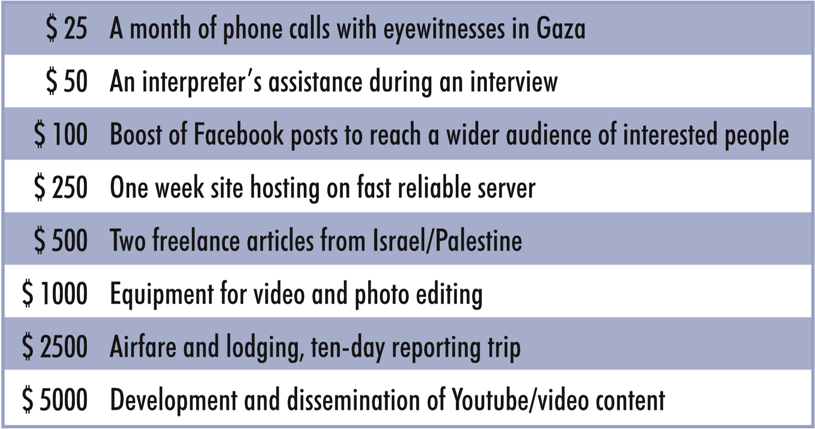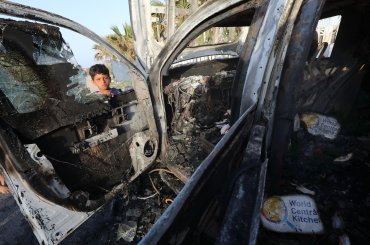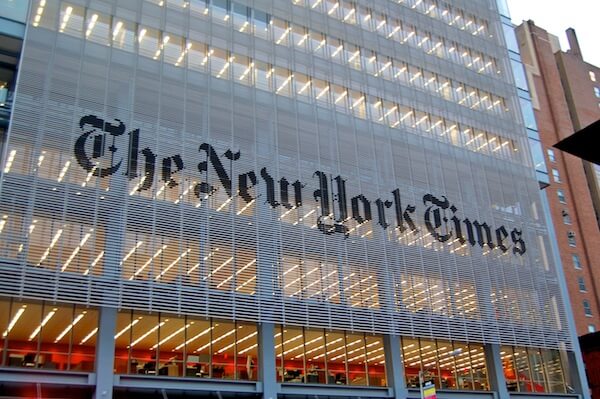Last week, we extended our “Be The Mondoweiss Megaphone” fundraising campaign until the end of July in order to be sure that we could meet our $50,000 goal and increase Mondoweiss’s impact for better U.S. foreign policy, fostering justice in Israel/Palestine.
Well, we won’t need the rest of July—as of today, we are only $381 from the goal! All we need now is for you to join hundreds of others by giving now, at whatever level you can. Your support enables in-depth reporting on the fight for Palestinian rights—on the ground, in the U.S., and around the world.

Here are some of the ways your donations make a difference:
We continue to be inspired and moved by the flow of stories readers are sharing with us about their journey to the movement for Palestinian human rights. Today’s post is by Cathy Sultan, chair of Interfaith Peace Builders and author of award-winning books including “A Beirut Heart: One Woman’s War,” “Israeli and Palestinian Voices: A Dialogue with Both Sides,” and “Tragedy in South Lebanon: The Israeli-Hezbollah War of 2006.” Please join Cathy in sharing your story with us at submissions@mondoweiss.net.
If you, like Cathy, believe that the voices in Mondoweiss make a difference for justice in Palestine, please contribute today to continue and expand the work you value. Click here to see how dollars and cents are transformed into truth-telling. Please give whatever you can, and tell others who value good journalism why you choose to support this work.
My road to political activism was an unusual one. I grew up in Washington, D.C. in an Irish-German Catholic family. In 1966 I married a Lebanese physician and in 1969 moved to Beirut with our two toddlers. I followed the ’67 war though the eyes of my husband but I was a naïve young American who understood precious little about its long-term implications.
As a foreigner bewitched by her new city, it was easy to be distracted, at first, by Beirut. In 1969, it was at the height of its glory and the ‘Paris of the Middle East.’ But there was an uglier side to Beirut, the glimpse I caught on the day we arrived of corrugated tin-roofed hovels behind a barbed wire fence along the airport road. These were the Palestinian refugee camps of Sabra and Shatila. In ever-increasing numbers, too, Lebanon’s Shiites began arriving from the south where the Israeli Army was systematically destroying their villages. By March ’75, it was apparent that the city was coming undone.
On April 16, 1975, Christian militia, in response to an attack on their leader, fired on a bus carrying Palestinians, killing 27. By evening, clashes between Christians and Muslims were spilling into nearby neighborhoods. Young boys brandishing M-16’s took up positions behind makeshift barricades and began firing at one-time friends who had suddenly become rival militiamen. Snipers for both sides took up rooftop positions and picked off innocent men and women with the same indifference they would display if shooting targets. From that day forward, and for 15 long years, bursts of machine gun fire, mortar shells and carpet bombing broke into the former stillness of our nights.
My tranquil tree-lined street near Beirut’s National Museum became a deadly territorial divide—the infamous Green Line that separated east from west Beirut. As the war dragged on, my neighborhood became the center of major battles. It was shelled by Palestinian-led forces. Their snipers fired on my children. In 1982, I witnessed the Israeli invasion and saturation bombing of Beirut. Israeli tanks parked under our apartment building. I stood silent during those infamous September days when Christian militiamen entered Shatila Refugee Camp to slaughter some 2,500 Palestinian civilians. Our apartment was but a few blocks from the camp. Some of those militiamen were my neighbors.
That massacre marked the beginning of my political epiphany, the day I began to recognize a people both manipulated and abandoned by their leaders, a people who still live in squalid conditions both in refugee camps and under Israeli occupation in Palestine. My activism did not begin immediately. It took several years to clear my war-warped mind before I seriously contemplated a trip to Israel-Palestine. It eventually happened in March 2002 at the height of the suicide bombings and Ariel Sharon’s and his assault on Jenin and the West Bank.
Through my writing and activism, I became acquainted with Interfaith Peace Builders, a Washington, D.C.-based organization which leads delegations to Israel-Palestine to meet with peace activists from both sides of the divide. I have co-led three of their delegations and accompanied an IFPB delegation to the Gaza Strip in 2012. I was invited to sit on IFPB’s Board of Directors four years ago, and became its Chair on July 1st this year.
This past May I spent some time in the Shatila Refugee Camp, site of that 1982 massacre. While Shatila is some distance from Palestine and is not under Israeli occupation, its plight is no less stark. Overcrowded conditions in cinder-block units, piled helter-skelter one atop another with no heating, proper windows or doors to ward off the frigid rainy winters. An inadequate sewage system, staggeringly high unemployment, one free medical clinic, no hospital and insufficient schools for the ever-growing population. The residents—some of whom have lived there since 1948—are generous, warm-hearted, tenacious and above all determined to return to their ancestral homes.
According to Bill Moyer, the central task of all social movements is “to win the hearts, minds and support of the majority of the populace. Because it is people who will ultimately hold the power, they will either preserve the status quo or create change.”
Peace between Israelis and Palestinians is a goal toward which everyone should work. What can the vast majority of Americans, Israelis and Palestinians who are tired of endless wars and outside interference do? Often, it seems, very little. America, the democracy every country is encouraged to emulate, has witnessed an increasingly powerful executive wielding power at the expense of the vast majority of its citizens. Is this reason for despair or reason to act in order to reverse this course and create some hope for our future?
I strongly encourage the latter. At no time in recent history has our collective engagement been more urgently needed. We, the people, do have the power to create change, to influence and shape the policies of our governments. Now is the time to exercise that right. Now is the time to support the work of Mondoweiss, Interfaith Peace Builders, Jewish Voice for Peace, US Campaign to End the Occupation and others working toward a just and peaceful future for both Israelis and Palestinians.




Quite a woman! Wonder what her parents and family think about her life.
RE: “In 1982, I witnessed the Israeli invasion and saturation bombing of Beirut. Israeli tanks parked under our apartment building.“ ~ Cathy Sultan
MY COMMENT: Doesn’t that mean that the IDF was essentially using civilians as human shields?
RE: “This past May I spent some time in the Shatila Refugee Camp, site of that 1982 massacre.” ~ Cathy Sultan
SEE: “29 Years After the Massacre at Sabra Shatila” » By Franklin Lamb, Counterpunch, 9/17/11
ENTIRE ARTICLE – http://www.counterpunch.org/2011/09/16/29-years-after-the-massacre-at-sabra-shatila/
P.S. In Charlie Wilson’s War Congressman Wilson wrote about having visited the Sabra and Shatilla refugee camps shortly after the massacre(s). ‘In my usual knee-jerk fashion I assumed there was a certain amount of sensationalism in the press and assumed Israel’s culpability had been exaggerated, but I also felt it my duty to see for myself.’ P98. ‘When we got into the camps,’ he recalls, ‘the grief and mourning was still going on. It had been maybe a week since the attack, and we walked down and ran into this woman who was an American Jew…she told me that her people had done something terrible.
She walked us down to where the victims had been buried in a mass grave…. And I began to get a really terrible feeling in my stomach about it. And what was hanging over me was the Israeli guilt.’
‘But when we walked about fifty feet and one of the American embassy people showed me where the Israeli command post was, and I looked at it and at that moment I lost it. My heroes were forever blemished because they would have had to be blindfolded not to have seen and heard what was happening. And then it was clear that they set up the whole thing and sat there and watched it.’
SOURCE – http://www.fruitfulresearch.com/pdfs/sample_nonfiction_summary.pdf